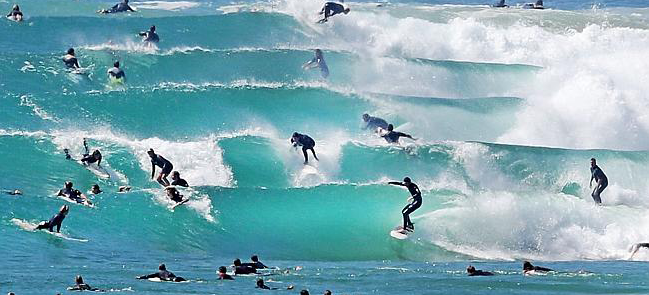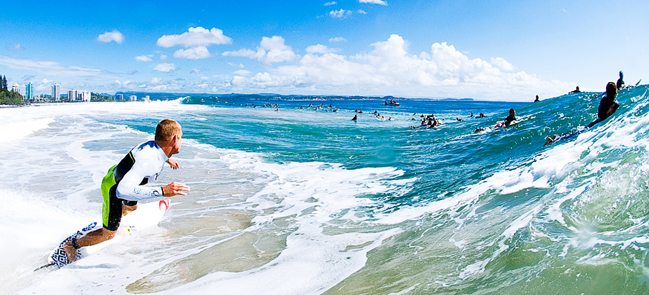Surfing Etiquette
How to Handle Yourself out in the LineupWe know that this might seem like an arbitrary article for some of you, but after just having Labor Day Weekend with pumping surf and tropical water temps here in Southern California, it seems that many people, including experienced surfers, seem to forget etiquette while out in the lineup.
Now, there are two ways we are looking at this. There are the beginners who simply do not know better and are in a totally new environment, and there are experienced surfers who just blatantly disregard etiquette because they feel they have more of a ‘right’ to be there over others.
Not saying that we are perfect here at Boardcave, we are guilty of ignoring etiquette ourselves from time to time, and we were all (including you the reader) beginners at one point who had no clue.
The trick here though, is that there is no written rule book or laws that apply. These are all un-written rules and for the most part, try to keep things organized and safe.
Spacial Awareness
One of the most important things to consider for a beginner, is that you have to be aware you are entering a new environment. It is easy to loose your focus and awareness right from the start when paddling out. A lot of beginners will get tunnel vision, focusing on what is directly in front of them. You need to be aware of this and only paddle out to the appropriate lineup for your ability. Being comfortable in the line up goes a long way for you safety, they safety of others, and how much fun you are going to have. If you can’t mange youself just paddling out, you are going to be in the way. Apart from the waves themselves doing you damage, your own board can become an uncontrollable blunt object ready to knock you and others out.

King Kelly has to battle for waves too, here he is being aware of his surroundings and taking a look before he commits to the wave.
Only paddle out on days or places you are comfortable with, and make sure you have the right Beginner board for your ability. Beginner Foam Surfboards or Soft Tops are a great option for this as they are safer for everyone if you do happen to get caught up in some carnage.
That special awareness really comes into play when your surfing progresses enough to be sitting in the line up. At this point, you have to be aware of where to paddle out, how to stay out of the way, and who has the right of way when everyone is paddling for a wave.
Paddling Out
When paddling out, your goal is to make it to the line up without getting in anyone’s way and with the least amount of effort as possible. But the effort goes to the wayside when it comes to being in the way.
On the way out, don’t assume someone surfing the wave can see you, and try not to ruin their wave even if they do. If you see someone coming down the line, but your best spot to duck dive under the wave is right in their path, paddle into the wave and deal with he white water…let the surfer continue on their way without having to dodge you. People will remember who is constantly in the way, and your chances for getting waves in the first place will dwindle if you are that person.

Try not to ruin someones wave and have your feet cut off. For your own safety, paddle into the breaking wave, not in the path of a surfer coming down the line.
Also, if possible, look for a channel to paddle out through. Many waves will break over a defined sandbar or reef of some sort. There is no sense in paddling directly out where the wave breaks when you can easily paddle around it. This way, you not only stay out of the way of other surfers, you will save yourself time and effort. The actual distance to the line up may be more, but if you are stuck in the impact zone, you will be paddling for ever and not make any headway.
And make sure, again, that you have the right equipment for what you can handle and the waves. Looking for information in articles like What Board Should I Surf, where you can make more informed decisions about picking right board for your abilities and the waves. Don’t try paddling a longboard out at a super hollow wave where you not only have difficulty getting past the breaking waves, but the board doesn’t fit the shape of the wave very well. This can turn into carnage really fast as a big heavy board just becomes a floating projectile when not in the right hands.
Right Of Way
Many waves peak over a certain sandbar, reef, or off a structure of some sort, around the same area over and over again. When there is a bit of a crowd, the unwritten “right of way” rules apply in an attempt to ensure that everyone gets their wave and gets it all to themselves. Keep in mind though, that as more and more people get into surfing, many times there are not enough waves for everyone on a general day, so drop in’s do happen and locals will know the line up better being able to be in the right spot time after time, and may just blatantly drop in on you. We are are guilty of this and you should just expect it when you go to a wave you do not know or surf very often.

We’ve all been in that lineup where drop-ins are frequent and it seems the locals happen to get all the good waves.
Generally, in a pack of people, you have to work your way up to being in the right spot. The surfer furthest out and closest to the peak of the wave usually has the right of way, and anyone else going for the wave should pull back and let them go.
This is a loose rule though, if you are closest to the peak but it takes you forever to get to your feet and the wave passes you by, a surfer outside the peak but up to their feet surfing first will have the wave. On the other hand, longboards and SUP’s can sit way out back and get into waves much earlier than short boarders on the inside. Yes, they should have the right of way as they will be into the wave surfing first, but if there are not that many waves and they are making it back out to the line up and taking every single wave, they need to be aware that there are others surfing too…before long they will just get dropped in on by other surfers who are getting frustrated by their actions.
Treat Others How You Want to be Treated
In the end, the number one rule really should simply be “treat others how you want to be treated”. Our parents have drilled this into us since we were able to walk, so it shouldn’t go out the window when we enter the water. Good Karma goes a long way when surfing with others.

Mick Fanning knows his local spot better than 95% of the people that surf there. He knows it is crowded, but he uses his local knowledge to snag the better waves and test out his boards from DHD Surfboards.
Let’s face it, for 99% of us surfing is an enjoyable past time, not a career breaker or life threatening problem that if you don’t surf you will die (although most of us feel that way). We are all out there to have a good time. If you are just dropping in, getting grumpy, putting out bad vibes, you are not having fun and more than likely pissing off others around you which will lead to you getting no respect and no waves.
When you are paddling out to a new line up, respect the locals who surf there everyday. You will be surprised at the number of waves you will get at a new spot if you show your respect. If you just go out and act like you own the line up, they will be quick to keep you from getting any decent wave.
On the other hand, if you are a local at your spot, realize that there are very few places left on this earth where the locals are the only ones out. Use your knowledge of the wave and your surfing experience to help determine what waves you get. You don’t have to just drop-in all the time, there will be other waves.
However, remember that navigating the world of surfing is not just about catching the perfect wave; it's also about adhering to surfing etiquette and ensuring safety in the water. That's where the right tools come into play. When you're looking for a great surf, remember to check out our wet suits for sale. They not only keep you warm but also protect you from the elements. Surfboard leashes are crucial not only for your safety but also for the safety of others in the lineup. They keep your board under control and prevent it from becoming a hazard. Plus, surfboard repair kits are your go-to when minor dings happen, ensuring that your board doesn't pose a safety risk to others. Don't forget about your hearing; surf ears can protect your ears from cold water and wind. And for added grip and control, surfboard traction pads are essential. With the right gear, you can enjoy the thrill of surfing while adhering to the unwritten rules of the lineup, ensuring a safe and organized experience for everyone.
Finally, have fun, share waves, put out good vibes and your surf session will be that much better.
Make sure you check out the Board Engine to find a range of boards all made in America by professional shapers at the top of their crafts. Email [email protected] with your details for a detailed report of board recommendations for you.








